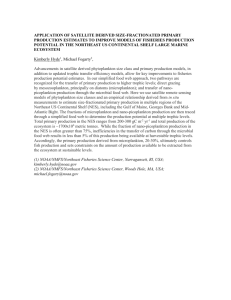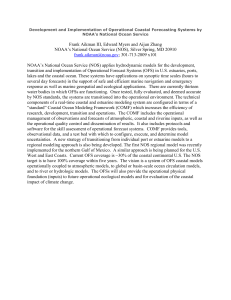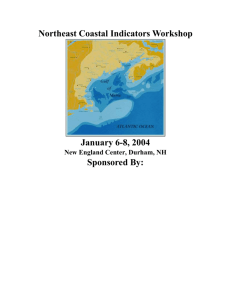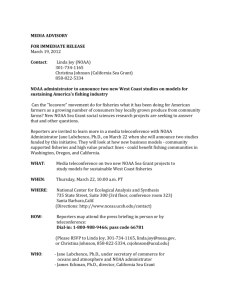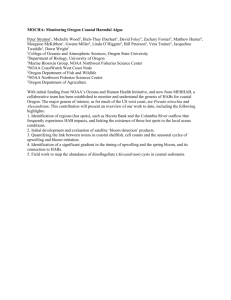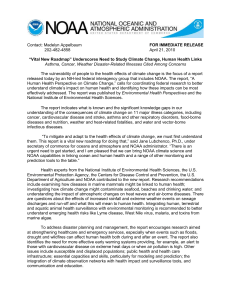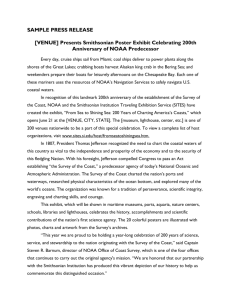NOAA in your State: MAINE
advertisement
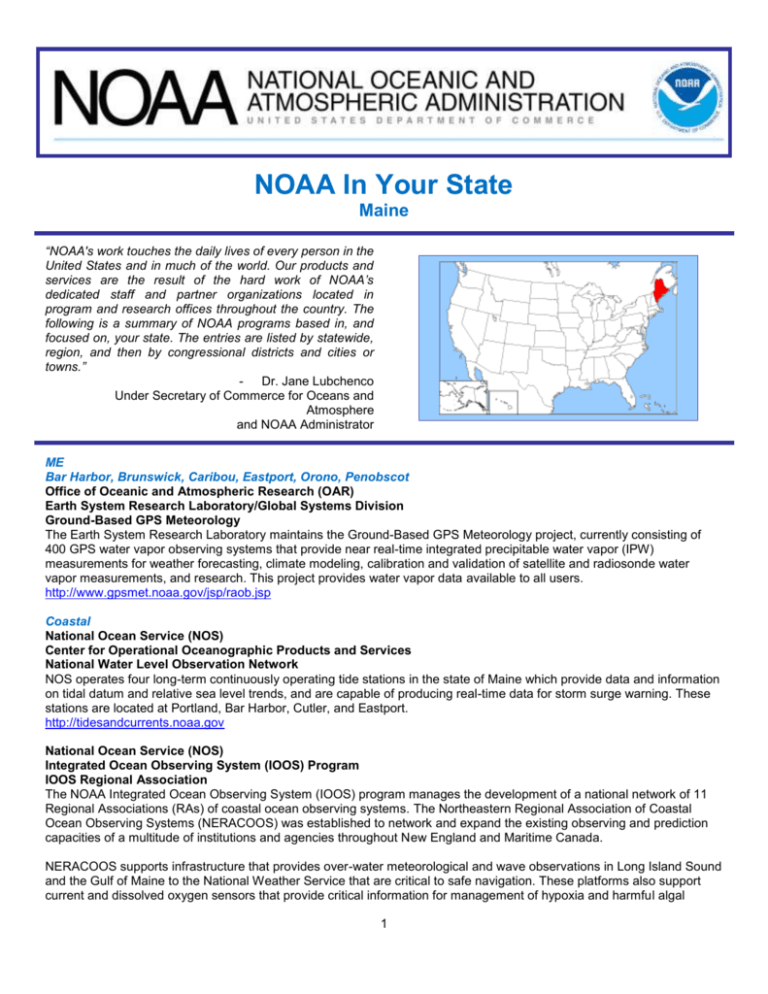
NOAA In Your State Maine “NOAA's work touches the daily lives of every person in the United States and in much of the world. Our products and services are the result of the hard work of NOAA’s dedicated staff and partner organizations located in program and research offices throughout the country. The following is a summary of NOAA programs based in, and focused on, your state. The entries are listed by statewide, region, and then by congressional districts and cities or towns.” - Dr. Jane Lubchenco Under Secretary of Commerce for Oceans and Atmosphere and NOAA Administrator ME Bar Harbor, Brunswick, Caribou, Eastport, Orono, Penobscot Office of Oceanic and Atmospheric Research (OAR) Earth System Research Laboratory/Global Systems Division Ground-Based GPS Meteorology The Earth System Research Laboratory maintains the Ground-Based GPS Meteorology project, currently consisting of 400 GPS water vapor observing systems that provide near real-time integrated precipitable water vapor (IPW) measurements for weather forecasting, climate modeling, calibration and validation of satellite and radiosonde water vapor measurements, and research. This project provides water vapor data available to all users. http://www.gpsmet.noaa.gov/jsp/raob.jsp Coastal National Ocean Service (NOS) Center for Operational Oceanographic Products and Services National Water Level Observation Network NOS operates four long-term continuously operating tide stations in the state of Maine which provide data and information on tidal datum and relative sea level trends, and are capable of producing real-time data for storm surge warning. These stations are located at Portland, Bar Harbor, Cutler, and Eastport. http://tidesandcurrents.noaa.gov National Ocean Service (NOS) Integrated Ocean Observing System (IOOS) Program IOOS Regional Association The NOAA Integrated Ocean Observing System (IOOS) program manages the development of a national network of 11 Regional Associations (RAs) of coastal ocean observing systems. The Northeastern Regional Association of Coastal Ocean Observing Systems (NERACOOS) was established to network and expand the existing observing and prediction capacities of a multitude of institutions and agencies throughout New England and Maritime Canada. NERACOOS supports infrastructure that provides over-water meteorological and wave observations in Long Island Sound and the Gulf of Maine to the National Weather Service that are critical to safe navigation. These platforms also support current and dissolved oxygen sensors that provide critical information for management of hypoxia and harmful algal 1 bloom. Fisheries managers, water quality specialists, the Coast Guard, and many others benefit from accurate and timely ocean observing infrastructure and related decision support tools. The region includes the coastal waters of Maine, New Hampshire, Massachusetts, Rhode Island, and Connecticut. There is overlap with the Mid-Atlantic Coastal Ocean Observing Regional Association (MACOORA), which also includes the coastal waters of Connecticut and Rhode Island. In addition, partners from the Canadian provinces of New Brunswick and Nova Scotia will be involved to ensure appropriate coverage in shared waters. http://www.neracoos.org/ Office of Oceanic and Atmospheric Research (OAR) Office of Ocean Exploration and Research Center for the North Atlantic and Great Lakes NOAA's Office of Ocean Exploration and Research focuses on exploration, advanced undersea technology development, research of extreme and unique environments, continental shelf ecosystems, new ocean resources, and ocean dynamics, and the communication of results to various audiences through education and outreach. NOAA's Undersea Research Center for the North Atlantic and Great Lakes (NAGL), one of the six NURP regional centers, is housed at the University of Connecticut. The NALG Center supports undersea research off the U.S.’s northeastern coast (i.e., Gulf of Maine, Georges Bank and the Southern New England Coast including Long Island Sound) and in the Laurentian Great Lakes. The center’s research focuses on ecosystem response to human induced stress such as fishing and pollution and the role of habitat in sustaining fisheries and biological diversity. Underwater diving technologies available through NAGL include occupied submersibles, remotely operated vehicles (ROV's), and Nitrox scuba. http://www.oceanexplorer.noaa.gov Office of Oceanic and Atmospheric Research (OAR) Pacific Marine Environmental Laboratory NOAA Center for Tsunami Research (NCTR) The Tsunami Research Program at the Pacific Marine Environmental Laboratory (PMEL), headquartered in Seattle, Washington, seeks to mitigate tsunami hazards to all U.S. coastal states and territories, including Maine. A tsunami is a series of very large ocean waves caused by underwater earthquakes, landslides, volcanic eruptions, explosions, and even meteor impacts. Capable of flooding hundreds of meters inland past the typical high-water level, the fast-moving water associated with an inundating tsunami can crush homes and other coastal structures. More common occurrences, and devastating in an economic sense, are false alarms that lead to expensive evacuations of coastal areas. The PMEL NCTR staff conducts research and development activities in close collaboration with the National Weather Service (NWS) Tsunami Warning Centers, National Data Buoy Center (NDBC), and the coastal states. Activities focus on the development of site-specific forecast models for coastal population centers. These models are integrated into a PMELdeveloped operational tsunami forecasting system at the Tsunami Warning Centers. PMEL developed the original realtime DART tsunami-measuring buoy, which has been transitioned to NDBC. Engineering development is underway at PMEL to improve the cost-effectiveness of these platforms. Tsunami research at PMEL focuses on model improvements and tsunami hazard mitigation. http://nctr.pmel.noaa.gov Statewide National Ocean Service (NOS) Coastal Services Center (CSC) Coastal Elevation Mapping The Center works with state and local officials to collect and distribute high-resolution topographic and bathymetric data sets. The Center worked with the private sector to acquire new light detection and ranging (lidar) and Interferometric Synthetic Aperture Radar (IfSAR) data for coastal management applications such as the analysis of storm surge and storm inundation, erosion, and habitat mapping. The Center also worked with state and federal partners to share costs and find multiple uses for coastal lidar and IfSAR data sets. http://www.csc.noaa.gov/crs/tcm/ National Ocean Service (NOS) Coastal Services Center (CSC) Coastal Inundation Visualizations Inundation from tropical storms (nor’easters) poses a significant threat to coastal regions in the Northeast. High-resolution visualization tools designed to help identify areas at risk of flooding are being developed for pilot locations in Scituate, Massachusetts, and Saco, Maine. The NOAA North Atlantic Regional Team has partnered with the National Weather Service to create a series of inundation layers using a GIS, as well as Google Internet applications, to illustrate potential flood inundation for real-time, forecast, hindcast, and scenario-based water levels. 2 National Ocean Service (NOS) Coastal Services Center (CSC) Community-Based Habitat Restoration NOAA’s community-based restoration program helps groups restore marine and estuarine habitat by providing funds and technical expertise. NOAA Fisheries leads the program. The Center has co-funded several projects, including the Drakes Island Marsh project in the Gulf of Maine region. http://www.csc.noaa.gov/ea/habitat.html National Ocean Service (NOS) Coastal Services Center (CSC) Habitat Priority Planner This GIS-based tool developed by the Center is for conservation and habitat restoration planners and practitioners to test different alternatives for setting management priorities within a watershed, county, or small region. The tool can be used to evaluate and compare the effects of future land use, conservation scenarios, or proposed restoration projects on habitat quality. Training and updated outreach materials are being developed and pilot application products are planned for Maine and two other states. http://www.csc.noaa.gov/hpp/ National Ocean Service (NOS) Coastal Services Center (CSC) Land Cover Mapping Nothing provides a big-picture view of land cover status better than these maps, which are developed using remote sensing technology. The Center has baseline land cover data for most of the coastal zone. The goal is to update the imagery every five years to also provide a means of detecting change or trends. http://www.csc.noaa.gov/landcover/ National Ocean Service (NOS) Coastal Services Center (CSC) Legislative Atlas This Web-based legislative mapping tool provides coastal resource managers with easy access to coastal legislative data and information. In 2008 the Legislative Atlas team added additional legislative information for the three regions represented in the atlas—Hawaii, West Coast, and the Gulf of Maine. This added information included both federal and state regulations. The legislative query tool is also being redesigned according to user input. http://www.csc.noaa.gov/legislativeatlas/ National Ocean Service (NOS) Coastal Services Center (CSC) Maine Coast Protection Initiative Over 70 organizations are working together to preserve the unique character of Maine’s coast. As a core partner in the Maine Coast Protection Initiative (MCPI), the Center supported the strategic conservation planning process, provided funding, and provided technical support to increase the geospatial capacity of the local land trusts. The Center also played a key role in establishing GIS resource centers designed to equip land trusts with the tools and training needed to better address coastal conservation challenges. http://www.csc.noaa.gov/conservation/mcpi.html National Ocean Service (NOS) Coastal Services Center (CSC) Training The Center provides training to the coastal resource managers of the nation in three focus areas: geospatial technology, coastal management, and building process skills. Training can take place at the Center’s training facility for some courses but most often is taken to coastal managers in the field. http://www.csc.noaa.gov/bins/resources/training.html 3 National Marine Fisheries Service (NMFS) Northeast Region Northeast Regional Office and Science Center NMFS is responsible for the management, conservation and protection of living marine resources within the United States' Exclusive Economic Zone (water three to 200 mile offshore). Using the tools provided by the Magnuson-Stevens Act, NMFS assesses and predicts the status of fish stocks, develops and ensures compliance with fisheries regulations, restores and protects habitat and works to reduce wasteful fishing practices, and promote sustainable fisheries. Under the Marine Mammal Protection Act and the Endangered Species Act, NMFS recovers protected marine species (i.e. whales, turtles). With the help of the six regional offices and eight councils, NMFS is able to work with communities on fishery management issues. The Northeast Regional Office (located in Gloucester, MA) is comprised of five divisions: Sustainable Fisheries, Habitat Conservation, Protected Resources, Fisheries Statistics, and State, Federal, and Constituent Programs. Key species managed in the Northeast Region include the northeast “multispecies complex” (cod, haddock, yellowtail flounder etc.), Atlantic sea scallops, herring, lobster, and summer flounder. Key marine endangered species in this region are Atlantic salmon, northern right whales, and Atlantic shortnose sturgeon. The Northeast Science Center (headquartered in Woods Hole, MA) focuses on collection, analysis, and presentation of scientific information about the Northeast Shelf ecosystem, its condition, and its marine life. In addition to its six laboratories, the Center uses 5 research vessels to support its work. They are: the NOAA ships Delaware II, and Henry B. Bigelow, and the small research vessels Gloria Michelle, Victor Loosanoff, and Nauvoo. The Northeast Regional Office and Science Center are responsible for the District of Columbia and the following states: Maine, New Hampshire, Massachusetts, Rhode Island, Connecticut, New York, New Jersey, Pennsylvania, Delaware, Maryland, Virginia, and North Carolina; and the inland states of Vermont, Minnesota, Michigan, Wisconsin, Illinois, Indiana, Ohio, and West Virginia. http://www.nero.noaa.gov/nero/ and http://www.nefsc.noaa.gov/ National Marine Fisheries Service (NMFS) Northeast Region Restoration Center NMFS’s Restoration Center works with 80 private and public partners in Maine to enhance fish passage at dams, widen bridges and culverts to improve tidal flushing in coastal wetlands, and restore river habitats and native wetlands. The Community-based Restoration Program’s partnership with Trout Unlimited has removed two dams, replaced a broken culvert that blocked fish passage in an Endangered Species Act listed Atlantic salmon river, and remediated more than five sediment sources on Maine’s salmon rivers. http://www.nmfs.noaa.gov/habitat/ National Weather Service (NWS) and Office of Oceanic and Atmospheric Research (OAR) Incident Meteorologist Program and Earth Systems Research Laboratory Fire Weather Services and Support The National Weather Service (NWS) fire weather forecasters are called Incident Meteorologists (IMETS). When a fire reaches a large, enough size the IMETS are called out to the fire to provide constant weather updates and forecast briefings to the fire incident commanders at the fire. The IMETS are very important members of the fire fighting team, as changes in the fires are largely due to changes in the weather. To improve NWS fire weather services to the public, NOAA’s Earth System Research Laboratory (ESRL) conducts modeling, instrumentation and data services research. ESRL data dissemination and display systems are designed to be used by trained meteorologists, the US Forest Service, and the Bureau of Land Management. For example, the FX-Net thin client system and the Gridded FX-Net full function system are ESRL-developed software systems are a critical part of the equipment the IMETS bring with them to the fire. NWS forecasters at fires in all 50 states use these mobile, PC–based software packages. Computer servers that communicate with the mobile PC clients are located in Hawaii, Alaska, Utah, Colorado, Texas and New York. State emergency managers in many of the NWS regional areas also use the PC-base clients. Other collaborators who work to improve NWS fire weather services include the University of Colorado in Boulder (CU), NCAR and private sector instrumentation companies. 4 Office of Oceanic and Atmospheric Research (OAR) National Sea Grant College Program Maine Sea Grant College Program NOAA’s National Sea Grant College Program is a federal-university partnership that integrates research, education, and outreach. Part of a network of 32 programs in the U.S. coastal and Great Lakes states, Puerto Rico, and Guam, Maine Sea Grant supports science and extension to promote sustainable use and stewardship of ocean and coastal resources. In partnership with University of Maine Cooperative Extension, members of our Marine Extension Team focus on issues of concern to Maine's coastal communities, extending current knowledge and expertise to residents, visitors, industry, and policymakers. http://www.seagrant.umaine.edu ME-1 Augusta National Ocean Service (NOS) Office of Ocean and Coastal Resource Management Maine Coastal Management Program The State Planning Office administers the Maine Coastal Program. Five state agencies work in cooperation with local governments, nonprofit organizations, private businesses, and the public to improve management of coastal resources. Maine’s coastal zone extends to the inland boundary of all towns bordering tidal waters and includes all coastal islands. At the state level, the Coastal Program provides support to natural resource agencies to implement and enforce appropriate laws. At the local level, the Coastal Program assists communities with land use planning and provides funding and technical assistance for other local efforts. The Coastal Program has succeeded in increasing local involvement in stewardship through its Coastal Stewards and Shore Stewards programs. Through its innovative Bay Management Study, the Coastal Program involves local citizens in managing their embayments by promoting sustainable use through support of both commercial and non-commercial uses and protection of natural resources. The Coastal Program also awards grants to local land trusts to help communities find and assert public rights-of-way to the shore that had been lost over time. http://coastalmanagement.noaa.gov/mystate/me.html Portland National Marine Fisheries Service (NMFS) Northeast Region Fisheries Statistics Office The Northeast Region Fishery Statistics Office port office is responsible for reviewing and auditing of fishery dependent data describing the commercial fisheries' landings in the local area. The fishery dependent data includes seafood dealer reports of purchases from fishing vessels, collection of biological samples from these landings and other information used by fishery managers and scientists to monitor and assess coast wide stocks of finfish and shellfish. Staff liaison with the local fishing industry, state marine fisheries agencies, and other constituents to assist with explaining fishery regulations including permitting, fisheries biology and other NOAA wide activities. http://www.nero.noaa.gov/fso/ National Marine Fisheries Service (NMFS) Office of Law Enforcement Field Office NOAA's Office of Law Enforcement is dedicated primarily to the enforcement of laws that protect and regulate our Nation’s living marine resources and their natural habitat. Special agents and enforcement officers have specified authority to enforce over 37 statutes, as well as numerous treaties related to the conservation and protection of marine resources and other matters of concern to NOAA. From the Maine/Canadian border south to the southern parts of Virginia lays one of the largest and most-active fishing fleets in the world. Over 12,000 federally licensed commercial, fishing vessels ply these waters in search of scallops, bluefin tuna, swordfish, monkfish, lobster and Atlantic cod. In the Northeast Division, the special agents and support personnel monitor thousands of recreational fishing vessels, 43 major seafood ports, 12 major seafood exchanges, 21 major international airports, and eight major entry stations from Canada. The Office of Law Enforcement Northeast Division is also responsible for enforcement activities within NOAA’s Stellwagen Bank National Marine Sanctuary off Massachusetts and Thunder Bay National Marine Sanctuary in Michigan. The Division has a vast assortment of missions to enforce laws across 84,000 miles of open water in the EEZ that are home to multiple endangered species including the critically endangered Northern Right Whale. 5 http://www.nmfs.noaa.gov/ole/ne_northeast.html Portland at Gray National Weather Service (NWS) Weather Forecast Office Portland WFO Located just outside of Portland, this National Weather Service office provides all the weather and flood warnings, daily forecasts, and meteorologic and hydrologic data for 19 counties (11 in Maine and 8 in New Hampshire), with a population of 1.6 million residents, covering western Maine and northern, central and southeast New Hampshire. NWS data and products form a national information database and infrastructure, which can be used by other government agencies, the private sector, media, the public and the global community. http://www.erh.noaa.gov/gyx Saco National Marine Fisheries Service (NMFS) Northeast Region Habitat Conservation Division & Restoration Center In Maine, NMFS, the U.S. Fish and Wildlife Service, Maine state resources agencies, conservation groups, and FPL Energy signed the 2007 Saco Fisheries Assessment Settlement Agreement, which enhances access for migratory fish at multiple hydropower dams over approximately 80 river miles on the Saco River from its mouth to the Maine and New Hampshire border. NMFS’ involvement helped turn license negotiations for one of the Saco’s dams into a watershed-wide conservation agreement. The Settlement is an ecosystem approach to river management that protects habitat necessary for the survival of migratory fish. The Settlement’s approach provides upstream and downstream fish passage for Atlantic salmon, American shad, alewife, blueback herring, and American eel at the river’s lower six hydropower projects. These approaches include studies to evaluate fish passage and management needs at specific dams; enhance stocking efforts for Atlantic salmon throughout the Maine portion of the Saco watershed; and help educate the public about migratory fish and the need for their passage at dams. http://www.nmfs.noaa.gov/habitat/restoration/; http://ww.nero.noaa.gov/hcd/ Wells National Ocean Service (NOS) Office of Ocean and Coastal Resource Management Wells National Estuarine Research Reserve The Wells Reserve, managed by the Reserve Management Authority, was designated in 1984 and encompasses 2,250 acres. Wells features a saltwater farm with historic buildings (circa 1720-1903) and an 11-kilometer trail system winding through fields, forests, wetlands, salt marshes, dunes and beach. The Greek Revival-style house accommodates a visitor center and exhibit. The reserve sponsors a workshop series for adults and educational services for children, including a "Junior Researchers" summer program. Tours on wildflowers, birds, cultural history, and research activities are available for the public. Whitetail deer, snowy egrets, soft shell clams, winter flounder and piping plovers find a home in the Wells reserve. http://nerrs.noaa.gov/Wells/ ME-2 Argyle Office of Oceanic and Atmospheric Research (OAR) Earth System Research Laboratory/Global Monitoring Division Monitoring the Atmosphere-Tall Tower Carbon Measurements NOAA's Earth System Research Laboratory (ESRL) operates trace gas monitoring sites at tall television transmitter towers in five states, including Maine. The sites were established to extend ESRL's monitoring network into the interior of North America in order to provide data to aid estimation of the net carbon balance of the continent. Variations of trace gases, especially carbon dioxide, are largest near the ground, so we utilize existing tall (> 400 meter) transmitter towers as platforms for in situ and flask sampling for atmospheric trace gases. http://www.esrl.noaa.gov/gmd/ccgg/towers 6 Office of Oceanic and Atmospheric Research (OAR) Earth System Research Laboratory/Global Monitoring Division Monitoring the Surface Atmosphere - Cooperative Global Air Sampling Network NOAA’s Earth System Research Laboratory (ESRL) operates a Cooperative Global Air Sampling Network to measure the distribution and trends of carbon dioxide (CO2) and methane (CH4), the two gases most responsible for human-caused climate change, as well as other greenhouse gases and volatile organic compounds. Samples are collected weekly at fixed locations and on several commercial ships. The air samples are delivered to the ESRL laboratory, located in Boulder, CO. The observed geographical patterns and small but persistent spatial gradients are used to better understand the processes, both natural and human induced, that underlie the trends. These measurements help determine the magnitude of carbon sources and sinks in North America. http://www.esrl.noaa.gov/gmd/about/climate.html Caribou Office of Oceanic and Atmospheric Research (OAR) Earth System Research Laboratory/Global Monitoring Division Total Column Ozone Measurements NOAA's Earth System Research Laboratory (ESRL) makes measurements of the column amounts of ozone between the earth's surface and the top of the atmosphere at a number of locations around the United States, including Caribou, ME. The observations are obtained with ground-based spectrometers that measure the attenuation by ozone of ultraviolet light. This integrated ozone amount is critical in determining the amount of ultraviolet radiation reaching the earth's surface. Excess ultraviolet radiation is responsible for human skin cancer and is also harmful to other biogenic organisms. Column ozone measurements monitor changes in the stratospheric ozone layer resulting from human-produced chlorine and bromine compounds that destroy ozone. With controls now in place on the manufacture and use of these ozonedestroying compounds, it will be important to monitor the ozone layer for the expected recovery and determine whether other factors such as long-term climate change are influencing this recovery. http://www.esrl.noaa.gov/gmd/about/ozone.html Caribou/Northern and Eastern Maine National Weather Service (NWS) Weather Forecast Office Caribou WFO Located in the town of Caribou, this National Weather Service Weather Forecast office provides weather and flood warnings, daily forecasts and meteorologic and hydrologic data for six counties, serving a population of 316,000 residents, in northern and central Maine including coastal areas north and east of Rockland. http://www.erh.noaa.gov/car Ellsworth National Marine Fisheries Service (NMFS) Office of Law Enforcement Field Office The NOAA Office of Law Enforcement, Ellsworth Field Office provides law enforcement support for Downeast Maine. From the Maine/Canadian border south to the southern parts of Virginia lays one of the largest and most-active fishing fleets in the world. Over 12,000 federally licensed commercial, fishing vessels ply these waters in search of scallops, blue fin tuna, swordfish, monkfish, lobster and Atlantic cod. In the Northeast Division, the special agents and support personnel monitor thousands of recreational fishing vessels, 43 major seafood ports, 12 major seafood exchanges, 21 major international airports, and eight major entry stations from Canada. The Office for Law Enforcement Northeast Division is also responsible for enforcement activities within NOAA’s Stellwagen Bank National Marine Sanctuary off Massachusetts and Thunder Bay National Marine Sanctuary in Michigan. The Northeast division has a vast assortment of missions to enforce laws across 84,000 miles of open water in the U.S. Exclusive Economic Zone that are home to multiple endangered species including the critically endangered Northern Right Whale. http://www.nmfs.noaa.gov/ole/ne_northeast.html 7 Limestone National Environmental Satellite, Data, and Information Service (NESDIS) and Office of Oceanic and Atmospheric Research (OAR) Climate Reference Network Limestone Station The U.S. Climate Reference Network (USCRN) is an operational network of climate stations. Data from the USCRN will be used in operational climate monitoring activities and for placing current climate anomalies into an historical perspective. NOAA's National Climatic Data Center (NCDC) manages the USCRN. The USCRN will also provide the United States with a reference network that contributes to an International network under the auspices of the Global Climate Observing System (GCOS). NOAA’s National Environmental Satellite, Data, and Information Service and NOAA’s Office of Oceanic and Atmospheric Research jointly manage USCRN. http://www.ncdc.noaa.gov/oa/climate/uscrn/ Old Town National Environmental Satellite, Data, and Information Service (NESDIS) and Office of Oceanic and Atmospheric Research (OAR) Climate Reference Network Old Town Station The U.S. Climate Reference Network (USCRN) is an operational network of climate stations. Data from the USCRN will be used in operational climate monitoring activities and for placing current climate anomalies into an historical perspective. NOAA's National Climatic Data Center (NCDC) manages the USCRN. The USCRN will also provide the United States with a reference network that contributes to an International network under the auspices of the Global Climate Observing System (GCOS). NOAA’s National Environmental Satellite, Data, and Information Service and NOAA’s Office of Oceanic and Atmospheric Research jointly manage USCRN. http://www.ncdc.noaa.gov/oa/climate/uscrn/ Orono National Marine Fisheries Service (NMFS) Northeast Regional Office / Northeast Fisheries Science Center Atlantic Salmon Field Office The Atlantic Salmon Field Station houses staff from the NMFS Northeast Regional Office and the Northeast Fisheries Science Center. Its mission is primarily to support restoration of Atlantic salmon throughout New England, particularly the endangered Gulf of Maine Atlantic salmon. http://www.nefsc.noaa.gov/nefsc/orono/ and http://www.nero.noaa.gov/prot_res/altsalmon/ NOAA’s Office of Legislative Affairs Tel: 202-482-4981 http://www.legislative.noaa.gov 8 9


